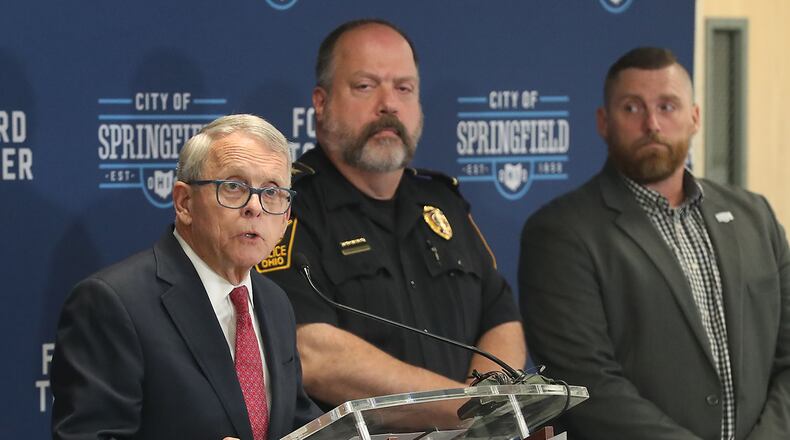Ohio Gov. Mike DeWine announced the third round of the grant funding at Springfield City Hall Monday morning. Sixteen law enforcement agencies in the state will receive a portion of $3.9 million in this funding round.
The Ohio Violent Crime Reduction Grant Program, created last year, aims to provide more resources to communities to address violence. DeWine said the nature of how gun violence presents itself throughout the state is changing, with more young people committing and dying by gun violence.
“Springfield is not immune to what we’re seeing,” DeWine said. “We really target violent crime. We’re seeing our cities become shooting galleries, and people have the right to be safe in their neighborhoods and live in peace.”
Springfield’s $305,206.94 allotment will cover the cost of more than 40 surveillance cameras to be placed in “hotspots” of violent activity, Springfield Police Division Chief Lee Graf said Monday.
Graf said that a picture is worth a thousand words, as the adage goes, but video can “fill a whole novel.”
“It can give us the ‘how’ and ‘why,’” Graf said.
Clark County Prosecutor Dan Driscoll agreed, saying surveillance footage may assist in telling the stories of victims and help “fill in the blanks” of what happened when witnesses are not coming forward.
The surveillance technology will operate much like security cameras for homes and businesses.
“The job of proving someone guilty has become more and more complicated,” Driscoll said.
Grant funding will also cover the purchase of technologythat automatically read license plate numbers.
In the first five months of the year, the Springfield Police Division has received more than 500 calls related to shots fired or in regard to firearms, according to the police division.
Graf said that the national rise in gun violence reverberated in Springfield: the city saw shots fired incidents double from 2019 to 2020.
The city has seen three homicides so far this year: in March, 16-year-old Melvin Belle died following a shooting at an event venue on South Yellow Springs Street. In April, 37-year-old Joshua Tackett was killed near Springfield Soup Kitchen. Markeese Brown, 19, faces charges of tampering with evidence, carrying a concealed weapon and discharging a firearm into a habitation in connection to the death of Tackett.
Most recently, a young woman in May was killed in a shooting where four others were injured. The death of the Springfield woman, De’Arion Welliford, 23, remains under investigation, and Graf said her death was “tragic and senseless.”
“As a community, we need to do everything we can to stop gun violence,” Graf said. “Officers are responding to calls daily and patrolling the community.”
Grants announced in the third round are all funded through the American Rescue Plan Act (ARPA), according to DeWine’s office. Several agencies in Franklin, Mahoning, Washington, Harrison, Lake, Scioto, Cuyahoga, Mercer and Meigs counties were also awarded in this grant cycle.
To date, $9.6 million has been awarded to Ohio’s law enforcement agencies through the grant program.
By the Numbers:
3: Number of homicides in Springfield in 2022
500: Estimated number of calls made to Springfield Police Division in regard to shots fired or firearms
3.9: Number in millions awarded to law enforcement agencies in the Ohio Violent Crime Reduction grant’s third round
About the Author

